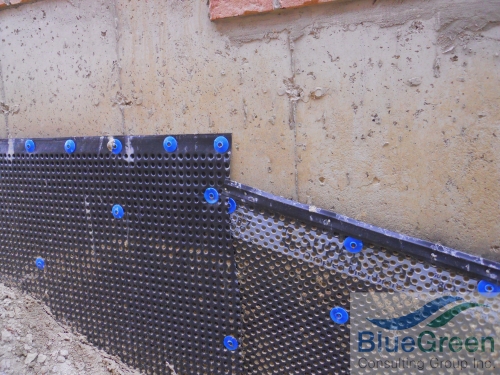We use drainage gaps or planes in wall systems to stop water from entering the building shell and causing deterioration or mold. This air gap if wide enough;
- Prevents water’s surface tension from staying or even climbing up the wall,
- Disperses the forces of wind driven rain or solar vapour drive.
- Make null and void any good insulation intentions if the R-value is on the cold side of the drainage plane.
We should explore some common problems that occur with this design feature.
When dimpled membranes were first introduced on the market for below grade applications, manufacturers were quite explicit about the need to fasten the top edge of the membrane with a terminal strip. They still are!
The goal of a dimpled membrane is to create and air pocket between the concrete foundation wall and the membrane itself with the aim of allowing any water that get’s past the membrane to quickly fall down the air pocket to the footing drain. The beauty of the system is that it stops the forces of capillary action that might normally hold the water against the wall. In order to stop the forces of capillary action, you need an open clear gap though.
The strip plays an important role in preventing debris from falling into and filling that precious air gap. Its uncommon to see terminus strips installed on most job sites, but this is an easy fix; follow the manufacturer’s instructions!

Curious how the two were treated differently. On the left no terminus strip but on the right the strip was installed.
The other common sight is when the drainage gap behind brick is nearly filled with mortar. This is a serious problem to the point where mortar could hold a small column of water against the wall and will certainly prevent water from draining out. This could have issues in both season extremes.

This brick wall cross-section clearly shows the 1′ gap being filled with excess mortar against the sheathing.
Again, this problem can be easily addressed through simple training: Clear the plane as you go!

The drainage plane behind the stucco and the Oriented Strand Board (OSB) can be seen in the photo above. Note that insulation on the exterior side of the drainage plane is a mere decoration.
As we learned to avoid the stucco mold issues so common in British Columbia a decade ago, the drainage plane is placed on the face of the sheathing as in the photo above, where a capillary break can be seen on the back-side of the 1.5″ Expanded Polystyrene. It’s important to understand that all outboard R-value is null and void. The uncontroled air circulation behind the foam makes the additional R-value moot.
